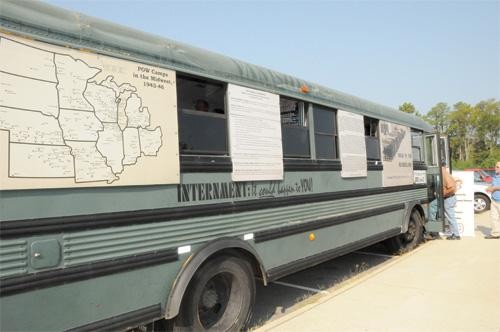FORT LEE, Va. (Sept. 30, 2010) - Fort Lee members got a taste of World War II history when a traveling exhibit visited here Friday.
The exhibit, "Held on the Homefront: German Prisoners of War in the United States, 1943-1946" is run by the TRACES museum in Michigan, said Irving Kellman, bus driver and tour guide of the exhibit.
TRACES is a non-profit educational organization created to gather, preserve and present stories of people from the Midwest and Germany or Austria who encountered each other during World War II.
"The purpose of the exhibit is to educate people about a little known fact that during World War II, the United States was home to 420,000 prisoners of war, held in about every state of the union," said Kellman. "There were 660 camps throughout the states - and more than 30 in Virginia."
There was also a POW camp at Fort Lee, which was known as Camp Lee at that time. The prisoners were held in the Jefferson Housing Complex. Additional information about the POW camp can be seen in the Quartermaster Museum on post.
The exhibit has been touring for eight years, and Kellman has worked it for five of those years. He said during the course of the exhibit he's learned a lot about the history of the German POWs and how well they were treated during their imprisonment.
It was thought that it would get back to Germany how well their POWs were being treated and that the American POWs would benefit. While that was not always the case, Kellman said he had heard many stories from American Soldiers who escaped German prisons about benefitting from the American treatment of the German POWs.
During the exhibit's stop on Fort Lee, several people with ties to the camps visited.
Scott Rogers, who served in the military until 1945, said he got a job watching 20 German POWs install lockers in the stadium at Kansas State University in Manhattan.
Erwin Harlfinger, a German ex-POW from Camp Butner, N.C., visited the exhibit and said he was a prisoner from 1945-1947 after he was captured in Holland. German POWs were transported by sea. Harlfinger said his journey took 23 days from France to New York.
Once he arrived at his camp, he said he worked in peanut and cotton fields, depending on the season.
He said he was treated well, and after being released back to Germany, he returned to the states because he didn't relate well to Germans any longer. He settled in Richmond, and eventually became a doctor.
The traveling exhibit has moved on to Delaware but will return to Virginia Nov. 13.
For more information about the exhibit or for future stops, visit www.traces.org and click on the "current" link under the title current traveling exhibits on the bottom right of the page.


Social Sharing